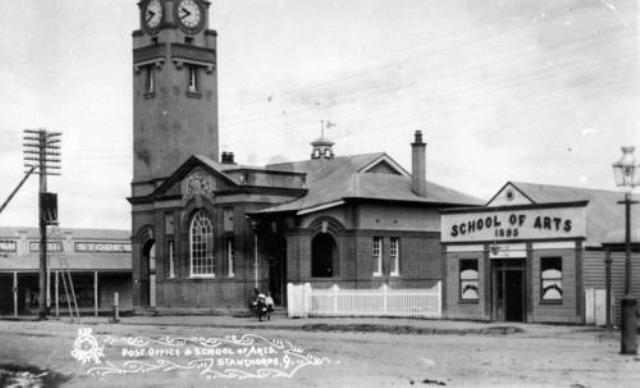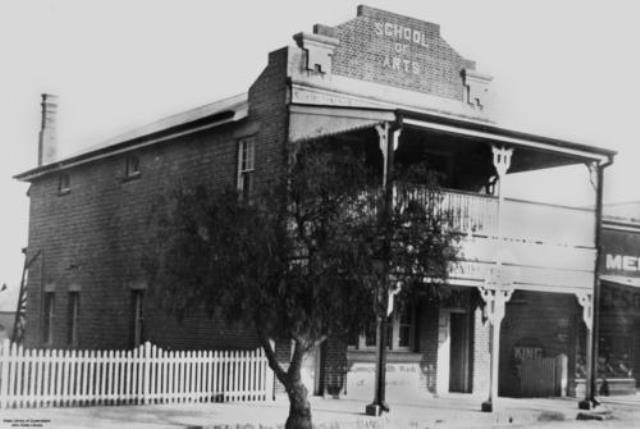Historian ROBERT MacMAURICE looks at the history of the Stanthorpe School of Arts.
Just about every little town used to have a School of Arts. Some still do. They were the cultural centres of every town. Stanthorpe was no different.
Government support for these institutions was strong. The Queensland Government Gazette of 15 March 1873 notified reserves of Crown land in Stanthorpe for, a Police, Customs and Commissioners, Post Office and the School of Arts. This early gazettal of such land in the company of other areas being set aside for town use are an indication of the importance that the Government placed in the establishment of Schools’ of Arts. Not only that the Government provided regular grants for running costs.
The gazetted ground for the School of Arts was a good acre located opposite the proposed post office in Marsh Street. Neither was ever built in that location, though, because the natural growth of the business district was occurring in High and Maryland Streets.
The first meeting to establish a School of Arts in Stanthorpe occurred in May 1874. The first president was Mr Henry George, Messrs Dixon and Cane were appointed joint secretaries; treasurer, Mr John de Poix Tyrel, and the committee consisted of Messrs. Allman, Austin, Brunckhorst, Foxton, George, Hawe, Hume, and Potier. This committee was a band of very able men. Mr Foxton and Mr de Poix Tyrel, for instance were long standing representatives of this electorate in the State Parliament. The others also achieved distinction in other areas, but that strays away from this story for the moment.
The first Stanthorpe School of Arts was built in 1895, as a single storey building on the north side of, and beside the current Post Office (the site originally of Groom’s Hotel).
The activities of the School of Arts, like all organisations waxed and waned. From time to time there was a lack of interest in the community according to the leadership and drive of the committee. The fundamental activity was the provision of a library lending service. Along with this though, the School of Arts, was a centre for lectures, plays, musical recitals, speeches, social occasions. Other organisations that used the School of Arts facilities were diverse, including, euchre tournaments, Stanthorpe Fire Brigade, Poultry and Kennel Club, Stanthorpe Bowling Club, Boomerang Football Club, Stanthorpe and District Amateur Rugby League, Ex-Imperial Service Association, Stanthorpe Operatic Society, and many others. One usage that caught my attention was tutoring for steam train drivers. I’m assuming this was the theoretical and not the practical sessions! There was also commercial use, because for many years the Commonwealth Bank rented space to conduct business, in the School of Arts.
In 1923 a decision was made by the new School of Arts Committee under the presidency of Dr F. W. Harlin, but more particularly the secretary Mrs E. Gilling, to build a new School of Arts building. It was decided that a two storey brick building would more accommodate the community needs. Architects Dornbusch and Connolly from Warwick provided a design and tenders were advertised in 1926 for the removal of the old building and erection of the new.
Mr. E. Gleeson was the successful tenderer for demolition and removal of the old building. Mr. L. J. Wilmot’s was the successful tenderer (out of four) for construction of the new building, which was completed in 1926. That is the building that is there to this day and currently occupied by the Chemist.
A point of interest is that it was Mr L. J. Wilmot’s father who had built the original school of Arts in 1895.
The Commonwealth bank took up renting the ground floor space and two small offices up stairs were also rented, to others, by the School of Arts. This income was necessary to pay off the loan for the construction of the new building. Mrs. E. Gilling, who was secretary for ten years was praised as being very instrumental in the organising of this finance and the planning for the new building.
All good things come to pass however. Community needs were changing. Perhaps the biggest change was the growing community demand for specialised library facilities run by professional librarians. Sporting clubs and other community organisations built their own facilities.
The State Government was aware that many Schools of Arts around the State were becoming vacant and without functional committees. Legislation was enacted, “School of Arts (Winding Up and Transfer) Act 1960,” to allow local Councils to take over the resources of existing Schools of Arts. In Stanthorpe’s case this happened with the agreement of the last Committee, who handed over the building and all items owned, along with transfer of monies in accounts (which went into library services). Council began discussions began with Mr. T. Thompson (president) and Mesdames Wright, Morwood, and Rees who were Committee members, and an agreement was made about transfer arrangements.
In October 1963 the School of Arts had been vacated, books moved to temporary library premises pending construction of the Civic Centre, and the School of Arts building put up for sale. It sold into private ownership on 23 April 1964.
This was the end of an era. It was the School of Arts however, that spawned a richer cultural life in this town and others.
*This is an old article that has been digitised so our readers have access to our full catalogue.








